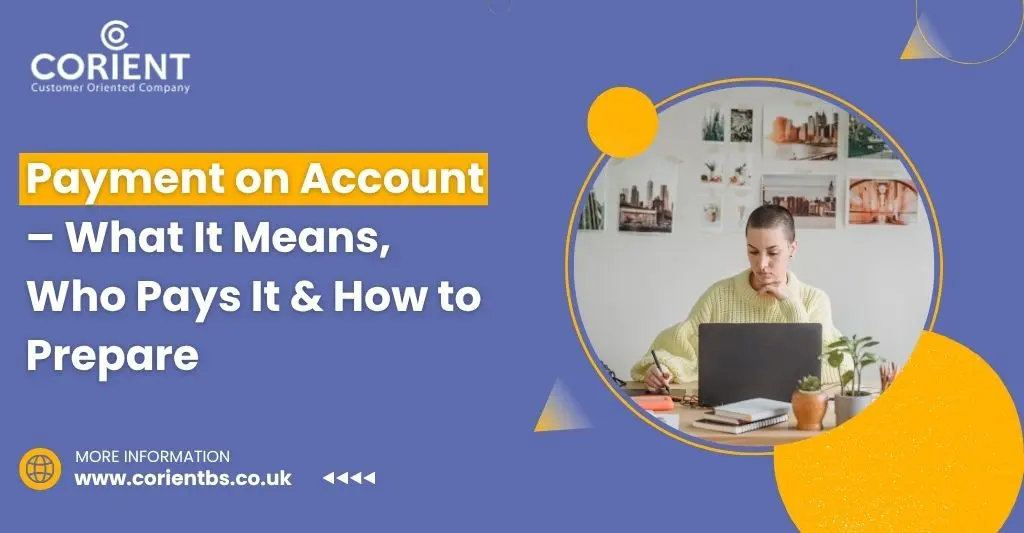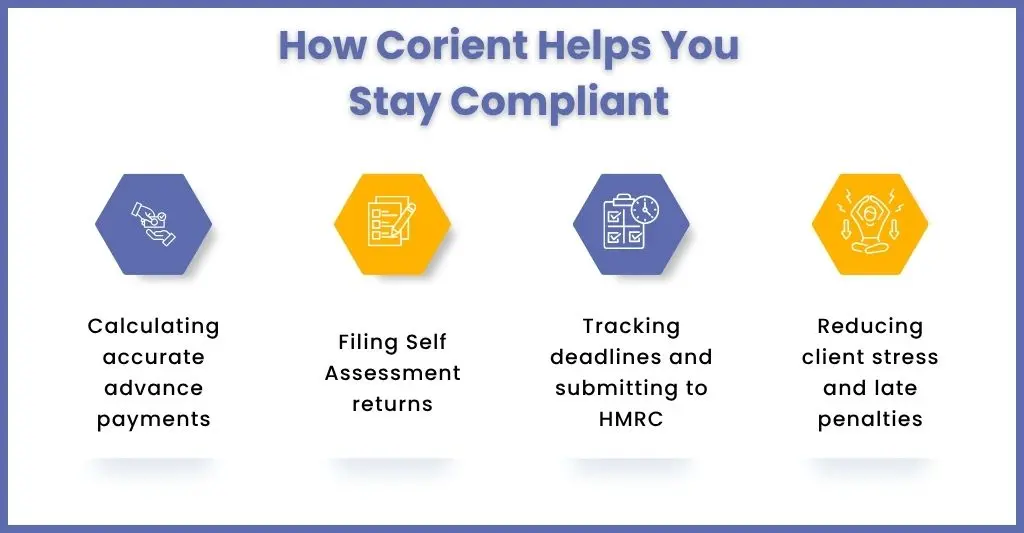
Payment on Account – What It Means, Who Pays It & How to Prepare
- What Is Payment on Account?
- How Does Payment on Account Work?
- Payment on Account Deadline, Key Dates You Must Know
- Do Your Client Need to Make a Payment on Account?
- How to Pay Payment on Account to HMRC
- Can You Reduce Your Client’s Payment on Account?
- Frequently Asked Questions (FAQ)
- Ready to Stay Ahead of Your Tax Payments?
Your self-employed clients may find themselves surprised and interested when you introduce them to payment on account. If most of your clients are self-employed, they must make a payment on account—an advance payment toward their future tax bill. HMRC introduced this system specifically for newly self-employed individuals whose income isn’t yet taxed at source. Self-employed individuals and others with untaxed income make these advance tax payments based on the previous year’s tax bill. They pay in two instalments—on 31st January and 31st July. If your client’s last Self-Assessment bill exceeded £1,000 and they paid less than 80% of their tax through PAYE, they must make a payment on account.
To avoid your clients from getting surprised by a payment on account, you will need to explain to them what it means, who is liable to pay it, and how to prepare it. To help you guide your clients, we have prepared a guide on this advanced tax payment system, which will simplify your task.
What Is Payment on Account?
The payment on account system allows self-employed individuals to make advance payments toward their future tax bills. HMRC calculates the tax amount based on the previous year’s income tax and Class 4 National Insurance contributions. This system helps your self-employed clients—or anyone whose income isn’t taxed at source—spread their tax payments across the year by paying twice, six months apart.
“Did You Know?
Nearly half of UK self-employed individuals are unaware they must make a payment on account until the last minute.”
How Does Payment on Account Work?
Many of your clients will have limited knowledge about payment on account and even less understanding of how it works. This system applies to those whose tax is not deducted at the source and spreads the cost. Let’s understand how this system operates:
Making an Estimate Based on the Previous Year
The HMRC will estimate your client’s tax liability by analysing the previous year’s tax bill.
Instalments
Once the amount is fixed, the instalments need to be equally divided.
- The first instalment is due by 31st January (which can include the balance amount of the previous year)
- The second instalment is due by 31st July
Calculations
HMRC calculates the payment on account based on the previous year’s tax bill. For example, if your 2024–25 tax bill is £4,000, you must pay £2,000 in advance for 2025–26, split into two instalments.
Making Adjustments
If the actual tax liability ends up being higher than estimated, your client will have to pay the balance by the 31st January. If it’s lower, they may receive a refund or offset it against future liabilities.
Understandably, your clients will not have a deep understanding of payment on account, so they rely on accounting practices like yours. However, these days, to save time and resources, practices are opting for accounting outsourcing services offered by expert service providers to streamline their operations.
Payment on Account Deadline, Key Dates You Must Know
Remember the deadlines related to payment on account. On or before these deadlines, your clients must make the payments to avoid any hassle. Here are the key deadlines to note:
- 31st January 2025: On this deadline, your practice on behalf of your client will have to make the balance payments of the previous tax year, submit your client’s self-assessment tax return, and make on their behalf the first payment for the current tax year.
- 31st July 2025: On this date, you will have to make a second payment for your client for the current tax year.
By explaining to your clients how payment on account works and its associated deadlines, you are helping them manage their finances effectively and avoid potential penalties. You must note that, like the payment of corporation tax deadline, HMRC charges interest on any outstanding amount if you miss the payment deadlines.

Do Your Client Need to Make a Payment on Account?
While working on payment on account for practices, we have come across an interesting fact: a significant proportion of UK businesses may not fully understand the payment on account requirements. Among the multiple queries we receive is the eligibility for making a payment on account.
Hence, not all of your self-employed clients are liable for payment on account. They must make the payment only if:
- Their last Self-Assessment tax bill was over £1,000, and
- Less than 80% of their tax was collected via PAYE
How to Pay Payment on Account to HMRC
Now that you’re aware of the internal workings of payment on account and who will be liable for it, let’s understand how your clients will make payments. Currently, there are many payment methods that the HMRC accepts; these are:
- Bank transfer (Faster Payments, CHAPS, or Bacs)
- Debit or corporate credit card (online)
- Direct Debit
It is essential to note that payment processing takes three working days if it is made through BACS, direct debit, or cheque. Hence, keep a watch on the deadline to ensure it does not fall on weekends or holidays. We recommend making payments well in advance of the deadline to avoid any hassle for your clients.
Can You Reduce Your Client’s Payment on Account?
HMRC determines the amount of payment on account based on last year’s tax bill. The regulatory agency will assume that your client will continue to earn at the same rate. Therefore, your client will also pay the same amount of tax in the following year.
The question that arises is how you will help your client reduce the payment on account. One way it can be reduced is when your clients’ income is taxed at the source, which will reduce the payment on account. However, caution must be exercised to ensure that if there is too much reduction in costs, HMRC will charge interest on the shortfall; therefore, it is essential to develop accurate estimates.
Frequently Asked Questions (FAQ)
There are two deadlines for payment instalments for payment on account. The first instalment must be paid by 31st January 2025, and the second instalment must be paid by 31st July 2025.
Payment on account is an advance towards your client’s future tax bill. The actual bill is calculated after the tax year ends, and individuals may owe more or less, depending on their actual income.
Payments on account are payments towards your next tax bill (including Class 4 National Insurance if you’re self-employed). They help spread the cost of your tax by making payments in 2 instalments. Each payment is half of the tax you owed last year. These payments are due by midnight on 31st January and 31st July.
For a refund, your client must receive a P800 tax calculation. It is essential that the calculation is verified and that the repayment due is accurate. HMRC used to issue many repayments automatically. However, with effect from 31st May 2024, HMRC is no longer issuing all repayments automatically.
The current late payment and late self-assessment instalment interest rates for payment on account are 8.25% (subject to change).
Ready to Stay Ahead of Your Tax Payments?
Payment on account, if not taken seriously, can throw up some nasty surprises, which will cost your clients dearly and damage your practice reputation. Through this guide, we are making it easy for you to make your clients understand the importance of this tax payment system. In this guide, we have made an effort to simplify the internal workings of accounts on payment, payment methods, and deadlines.
Using this guide, you can help your clients avoid cash flow surprises and last-minute panic. To further enhance your services, you can utilise the assistance of a professional service provider, such as Corient. At Corient, we help avoid nasty surprises for your clients and simplify the entire tax preparation work. We handle a range of accounting tasks, including payment on account calculations, HMRC filing, and deadline tracking, thereby reducing your workload and freeing up your resources. Use our contact form to share your requirements, and we will get in touch with you. Looking forward to seeing you soon.


